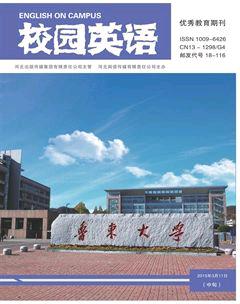Ad Translation from the Perspective of Functional Theory
2015-04-23张海强
【Abstract】Advertising translation,as a tool of promoting sales,plays an increasingly important part in the international arena.The objective of advertising translation is to persuade customers to make purchase or buy services.Therefore,functional theory is put forward to analyze advertising translation.Advertising translation is explored from the perspective of functional theory by reviewing Vermeers Skopos theory.Successful translation strategies such as structure-borrowing translation,Creative Translation and zero-translation are discussed through specific examples.It proves that advertising translation can be guided by functional theory.
【Key Words】functional theory; ad translation; Skopos theory; Creative translation; structure-borrowing
1.Functional Theory Related to Advertising Translation
Hans Vemeer made a breakthrough in functional theory by proposed his famous Skopostheorie.In Skopostheorie,the overriding principle is Skopos rule,which means that a translation action must be determined by its Skopos.That is to say,it must be the prospective function or intended purpose of the target text that determines translation strategies,rather than the source text.Vermeer describes Skopos as “the end justifies the means.”(Nord,2001:32)
Generally,the client who is regarded as the initiator of the translation offers the Skopos,that is,gives the information about the purpose,describing the addresses,time,place,occasion and medium of the intended communication and the function of the text wanted to achieve,and all this constitutes the so-called explicit translation brief.Although the client decides the Skopos of translation,the translation brief he gives is not clear,translators need to decide how to translate or what kind of translation strategies to employ.
2.Ad translation Strategies in Light of Functional Approach
In this chapter,varied successful ad translation techniques in light of Skopostheorie will be discussed.
2.1 Structure-borrowing Translation.Structure-borrowing translation refers to borrowing the set pattern of English expressions based on preserving the original advertising effects when Chinese ads are translated into English.(赵争鸣,2008)For example:
(7)百闻不如一尝 —— an ad by Grain and Oil Ex-im Company Tasting is believing.
This English advertising version is adapted form the well-known English proverb: Seeing is believing.The advertising effects are absolutely perfect.
(8) All is well that ends well.(an ad for cigarette)
烟蒂好。烟就好。(its Chinese translated version)
From the above examples,we can see that structure-borrowing translation is a proper strategy to achieve advertising effects in target language,since the readers can better remember the target text,which is familiar to them.
2.2 Creative Translation.Creative translation refers to the fact that the translation has no literal connection with the original,but the translation is widely accepted and regarded as the translation of the original.(刘重德,2006)It is not only translation but has certain creative hallmarks.For examples:
(9)The source text: Delicious simple,simply delicious.(fast food ad)
The target text: 美味便捷,美味至极。
(10)The source text: Good to the last drop! (an ad for Nest Coffee)
The target text: 滴滴香浓,意犹未尽。
Based on the above translations,it is obvious that their persuasive power for promoting sales achieve the same effect as the original.
2.3 Zero-translation.There are two kinds of zero-translation in ad translation.One is the name of a company,a brand or a series of products.These names needed not to be rendered and just applied directly to the target text.(周兆祥,1996) But in this part,we focus on the other kind of zero-translation,that is,the zero-translation sentences in the ad translation.For instance:
(11)The source text: Because ENERGY is essential and LIFE is precious.(Slogan) Doing what others dare not.
The target text: 能源虽是必须的,但我们更要尊重大自然的生命。
(口号) Doing what others dare not.
(12)The source text: Use the American Express Card to reflect your classic style.
(Slogan) Do more.
The target text: 使用美国运通卡,配衬经典型格。
(口号)Do more.
Generally speaking,all the information in the original text should be translated into target text.But when the slogans or headlines are dapper in the original text and are not easy to expressed in the target text,the translator will adopt headlines or slogans in English when the advertisement writing are rendered into Chinese.Since English enjoys increasing popularity in China recently,it iseasy for Chinese to comprehend such short and terse English.
3.Conclusion
Advertising, offers us a helping hand to learn about some information of products or services but its ultimate goal is to persuade consumers to take action to make purchase.(赵彦春2005)Therefore,advertising for products plays an increasingly important part in the international market,so does advertising translation.Vermeers Skopos theory has been proved to be an effective theory to explain utterance understanding and cognition but also to varied areas such as advertising translation.In light of Skopos theory,a couple of translation strategies of ad translation from English to Chinese is put forward.The strategies include literal translation,free translation,structure-borrowing translation,etc.All these translations strategies achieve the persuasive function of ads.
Reference:
[1]Nord.Translation and Translating:Theory and Practice[M].Foreign Language Teaching and Research Press,2001:32.
[2]Nida, Eugene A.Toward a Science of Translating[M].Shanghai: Shanghai Foreign Language Education Press,2005.
[3]杜争鸣.翻译策略与文化—英汉互译技巧详解[M].中国经济出版社,2008.
[4]刘重德.英汉语比较与翻译[M].上海外语出版教育社,2006.
作者简介:张海强,(1987.10—),男,汉族,广东雷州人,助教,硕士,研究方向为英语口笔译,英语语言文学。
